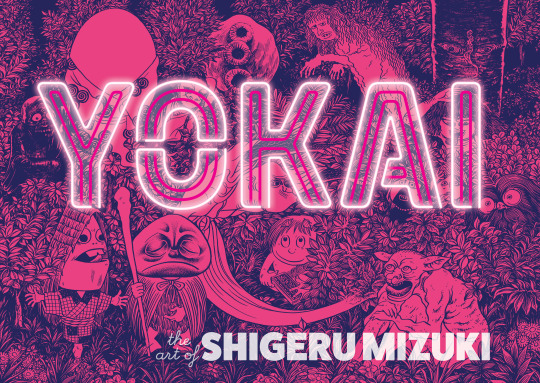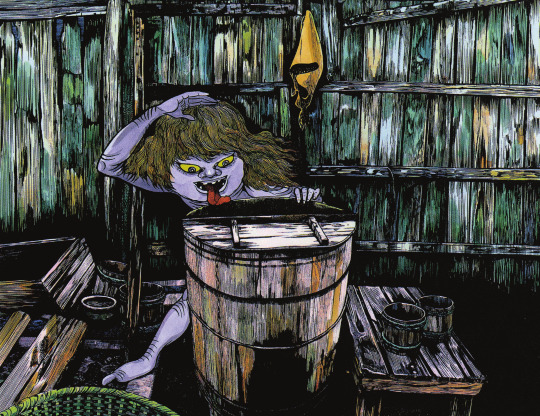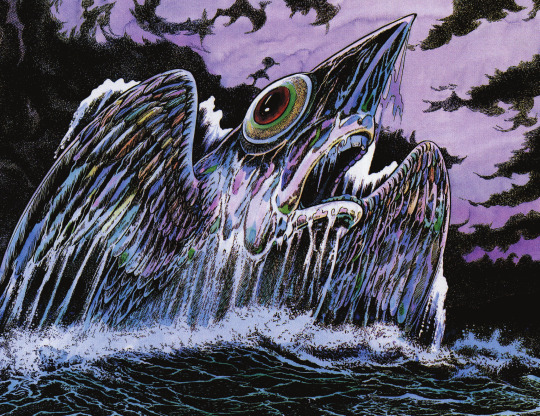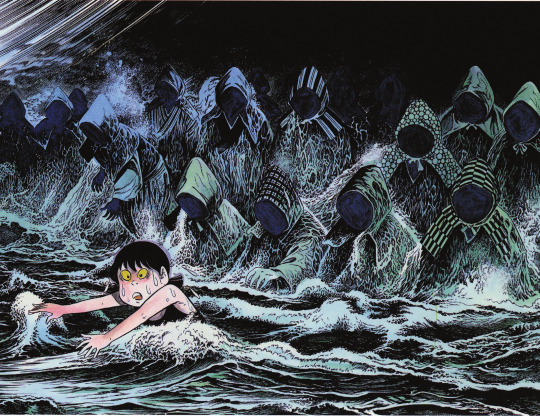#hoyau-kamui
Photo










Yokai: The Art of Shigeru Mizuki. Published 10/31/2023 by Drawn & Quarterly.
Shigeru Mizuki is no stranger to the supernatural and its portents. Kitaro and Tono Monogatari reimagined the obscure folktales of his youth, bringing them to life with whimsy. Mizuki the cartoonist certainly left an indelible mark on comics as world literature. Mizuki the fine artist, on the other hand, rounds out the full scope of his fascination with the otherworldly and fantastic, bringing these worlds to life in robust color.
Yokai: The Art of Shigeru Mizuki showcases his expertise of not only folklore, but celebrates him as a naturalist. Elements of Mizuki’s lush compositions—flora, fauna, and everything in between—showcase his mastery of form and love for nature. These popular renderings of a disappearing, rural Japan are his contribution to the preservation of a cultural heritage that would have otherwise been forgotten. The grotesque realism central to his body of work is offset by the ingenuity of his fancy for the macabre. Pieces in this deluxe, full-color edition call to mind the playful pop-sensibility of Maurice Sendak informed by the technical prowess of traditionalists like Dürer and Doré. And like any other Mizuki classic, each oeuvre is a unique snapshot of spirit, human or otherwise, in constant transition.
Yokai: The Art of Shigeru Mizuki includes supplementary writing by acclaimed Mizuki scholar and translator Zack Davisson.



#art#shigeru mizuki#folklore#japan#yokai#akaname#ichimoku-nyudo#ogome#tsurara-onna#hoyau-kamui#ho-onade#tenome#amabie#garappa#kappa#seko#shudan-borei#shirime
134 notes
·
View notes
Photo

Hoyau Kamuy [Ainu mythology]
Currently, there are a little over 10 000 Ainu people left in Japan, but these people have a rich tradition of folklore and mythology. The Kamuy (or Kamui) are a kind of spirits that play a central role in this religion. There are Kamuy of owls, of the moon, of snakes, etc. Hoyau Kamuy is the Kamuy of dragons.
Although this creature is often depicted as a giant winged goblin shark (and sometimes as a giant aquatic snake), it is a dragon spirit and apparently one of the more dangerous Kamuy, and it produced a powerful venom. During summer, its power grows, but in the winter it is weakened. In fact, it is often called “sak-somo-ayep” which roughly translates to “one who must not be mentioned during summer”. Since it detests the cold, it is known to possess shamanesses (“miko”) and command them to stoke fires. Some stories claim it can push other spirits out of the body of these shamanesses.
Legend has it that the deity Okikurmi defeated this monster with a cunning trick. The deity took on the form of a human and tricked the river-dwelling beast into visiting a village upstream. There it was approached by the villagers who offered it the hand of the elder’s daughter in marriage. The dragon accepted and the ceremony began, during which the dragon ate so much fish from the banquet that it got sick. The deity Okikurmi had used his magic to cast a potent illusion, for in reality there was no village, it was a giant hive of hornets whom the god had tasked with killing the dragon. And so, the evil beast was defeated. In another version, Okikurmi summoned a hailstorm, and the cold greatly weakened the monster so that Okikurmi could slay it with his divine sword.
Note that, depending on who you ask, there are multiple of these dragons, rather than a single individual. In fact, these dragons aren’t entirely evil and can act as local guardians to protect a village or location. They could also provide divine blessings and offerings were brought to them during epidemics, to make the illness go away.
(image source: Shigeru Mizuki)
#dragons#mythical creatures#myths#mythology#folklore#folktales#creatures#monsters#sea monsters#seamonsters#world mythology#fantasy#lore#DM
57 notes
·
View notes
Note
I notice your map has Hokkaido circled which I assume you're referring to the Ainu. However I personally felt Megami Tensei already has enough Ainu representation (already having three deities and the Koropokkuru) oppose to the Ryukyu who only Shisa and Kinmamon.
Yes, it's for the Ainu. I only count three in total, though: Koropokkuru, Hoyau Kamui, and Chironnupu. There's not even anything related to bears!
9 notes
·
View notes
Text
Something that fascinates me about the Devil Summoner/Soul Hackers era of megaten is the sheer number of new additions to the demon roster from mythologies either completely absent from the franchise before, or at most represented by a sprite recolor or two:
Ogun (Yoruba)
Dokkeabi (Korean)
Attis and Cybele (Phrygian)
Alilat (pre-islamic south semitic)
Dzelarhons (Haida)
Pele, Kanaloa and Kamapua'a (Hawaiian)
Maui and Tuna Roa (broadly Polynesian)
Panchacamac (Ichma - pre-Inca Peruvian)
Tangata Manu (Easter Island)
Kresnik and Kudlak (broadly balkan)
Rolwoy, Mokoi, Yurlungur (Australian; wiki has Putz under "australian" btw but it's... austrian...)
Tschaggatta (Swiss)
Penanggal, Tenong Cut (Malaysian)
Kinmamon, Kijimuna (Okinawan)
Hoyau Kamuy, Koropokkuru (Ainu)
Moh Shuvuu (Buryat)
Chagrin (Romani)
Inti (Inca)
Sedna (Inuit)
Ictinike (Lakota)
Holawaka (Oromo)
Moowis, Winpe, Malsum, Manitou, Nemissa, Kinap (Algonquin)
33 notes
·
View notes
Note
can you recommend me some books/website/source about Ainu mythology (especially I'm researching ones whose name is Atkor Kamuy/Akkorokamuy). I think Ainu mythology needs more love, beside Shinto myth (Okinawan mythology too...)
This is tough. I own one Ainu book, The Romance of the Bear God:

It’s a small collection of folk tales. I got it in Japan at a Book Off for 105 yen according to the price sticker on the front cover, which seems like it was a preeeetty, preeeetty, preeetty good deal. Good god, I wasn’t expecting that. It’s not a bad little book by any means but I don’t recommend paying $90 for it, it doesn’t have the breadth you’d want. Also, search for “Romance of the Bear God” on Amazon without quotes if you want to have an interesting adventure.
I know I picked the book up because at the time I wanted more concrete information about SMT’s Hoyau Kamui; of course, it wasn’t there (this was way before we pieced together that Shigeru Mizuki’s works were used as sources). Most websites are in Japanese; indeed, most of the more detailed stuff about Ainu myth seems to be in Japanese.
However, there’s a little hope. I just reviewed the mystery demons article and apparently Hoyau Kamui is mentioned in the book Songs of Gods, Songs of Humans: The Epic Tradition of the Ainu by Donald Philippi. Philippi is the translator/commentator of the best version of the Kojiki available in English and so while i haven’t read this Ainu book, based off the Kojiki work I feel confident that this book will be what you’re looking for (or the best you might be able to find in English). It’s also cheaper than my dinky little Romance of the Bear God. Maybe it’s time for an upgrade.
9 notes
·
View notes